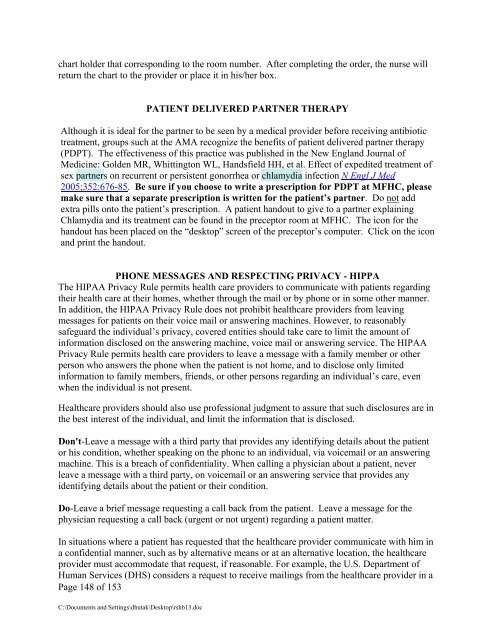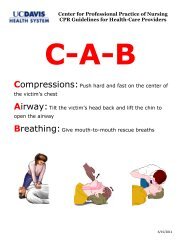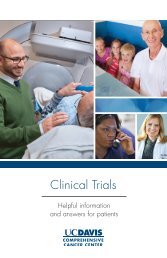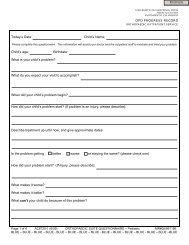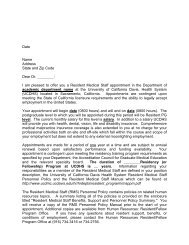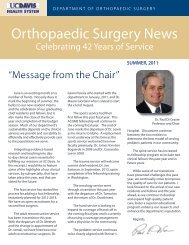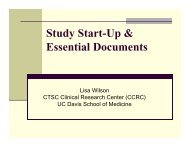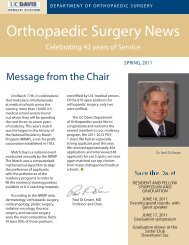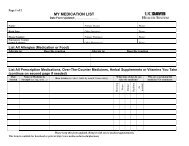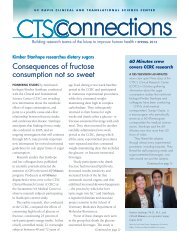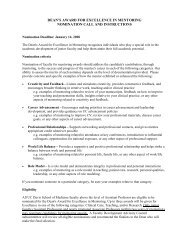Resident Handbook - UC Davis Health System
Resident Handbook - UC Davis Health System
Resident Handbook - UC Davis Health System
- No tags were found...
Create successful ePaper yourself
Turn your PDF publications into a flip-book with our unique Google optimized e-Paper software.
chart holder that corresponding to the room number. After completing the order, the nurse willreturn the chart to the provider or place it in his/her box.PATIENT DELIVERED PARTNER THERAPYAlthough it is ideal for the partner to be seen by a medical provider before receiving antibiotictreatment, groups such at the AMA recognize the benefits of patient delivered partner therapy(PDPT). The effectiveness of this practice was published in the New England Journal ofMedicine: Golden MR, Whittington WL, Handsfield HH, et al. Effect of expedited treatment ofsex partners on recurrent or persistent gonorrhea or chlamydia infection N Engl J Med2005;352:676-85. Be sure if you choose to write a prescription for PDPT at MFHC, pleasemake sure that a separate prescription is written for the patient’s partner. Do not addextra pills onto the patient’s prescription. A patient handout to give to a partner explainingChlamydia and its treatment can be found in the preceptor room at MFHC. The icon for thehandout has been placed on the “desktop” screen of the preceptor’s computer. Click on the iconand print the handout.PHONE MESSAGES AND RESPECTING PRIVACY - HIPPAThe HIPAA Privacy Rule permits health care providers to communicate with patients regardingtheir health care at their homes, whether through the mail or by phone or in some other manner.In addition, the HIPAA Privacy Rule does not prohibit healthcare providers from leavingmessages for patients on their voice mail or answering machines. However, to reasonablysafeguard the individual’s privacy, covered entities should take care to limit the amount ofinformation disclosed on the answering machine, voice mail or answering service. The HIPAAPrivacy Rule permits health care providers to leave a message with a family member or otherperson who answers the phone when the patient is not home, and to disclose only limitedinformation to family members, friends, or other persons regarding an individual’s care, evenwhen the individual is not present.<strong>Health</strong>care providers should also use professional judgment to assure that such disclosures are inthe best interest of the individual, and limit the information that is disclosed.Don't-Leave a message with a third party that provides any identifying details about the patientor his condition, whether speaking on the phone to an individual, via voicemail or an answeringmachine. This is a breach of confidentiality. When calling a physician about a patient, neverleave a message with a third party, on voicemail or an answering service that provides anyidentifying details about the patient or their condition.Do-Leave a brief message requesting a call back from the patient. Leave a message for thephysician requesting a call back (urgent or not urgent) regarding a patient matter.In situations where a patient has requested that the healthcare provider communicate with him ina confidential manner, such as by alternative means or at an alternative location, the healthcareprovider must accommodate that request, if reasonable. For example, the U.S. Department ofHuman Services (DHS) considers a request to receive mailings from the healthcare provider in aPage 148 of 153C:\Documents and Settings\dhutak\Desktop\rshb13.doc


